Wednesday, September 2nd 2020

Intel 11th Gen Core "Tiger Lake" & Xe Graphics Launch Event: Live Blog
Intel today launches its 11th Gen Core "Tiger Lake" mobile processors that introduce several new technologies on the backs of new IP. As described in the Architecture Day, "Tiger Lake" is built on the 10 nm SuperFin process, and combines new "Willow Cove" CPU cores with the first commercial debut of the Xe Gen12 graphics architecture that Intel is betting big on, to make a stab at the consumer graphics and scalar compute markets. Join us in this live-blog.Update 16:00 UTC: GB (Gregory Bryant, EVP Client), leads the event from the comfort of his home.Update 16:04 UTC: Here it is, the "world's best processor for thin and light laptops. You'll notice that like most Intel U-segment chips, this is an MCM of the processor and PCH die. Intel bases its "world's best" claims on a per-segment basis.Update 16:05 UTC: Acer, Dell, HP, Lenovo, and Samsung have devices with 11th Gen Core processor. Devices as light as 870 g, or lighter than the original Apple iPad. 50+ designs are expected for Holiday 2020, 150 will be available eventually.Update 16:07 UTC: Intel's new corporate identity takes flight with the new logos.Update 16:08 UTC: 10 nm SuperFin: 60 poly pitch transistor, improved gate process, higher mobility, lower drain resistance. We detailed this process node here.
Update 16:08 UTC: Super MIM capacitor is the second key component of 10 nm SuperFin. 20% iso power improvements.Update 16:10 UTC: 20% CPU IPC uplift, 2x iGPU performance uplift, 5x AI performance uplift, I/O improvements from Thunderbolt 4 and PCIe gen 4. Find out more about the Willow Cove core and CPU performance uplift in our technical article here.Update 16:11 UTC: LP/DDR5 memory support for future memory. "A processor evolved"
Update 16:12 UTC: Tiger Lake compact logic board for 2-in-1 tablets.Update 16:13 UTC: AI-accelerated performance much higher than AMD 4800U, as is CPU-heavy workloads. Much of Intel's design focus with this generation has been to leverage new AI-acceleration ISA, and suggest practical client-segment applications of the technology, such as in the area of video conferencing, where AI can be used to clear up your audio or blur/replace your background.Update 16:15 UTC: Intel claims iGPU gaming performance lead over AMD's 4800U, including FPS. The Iris Xe represents a generational leap in performance for Intel, and we've been tracking performance benchmarks of this solution for several months now, where it's been trading blows with AMD's Vega-based iGPUs.Update 16:18 UTC: Intel DLBoost will be heavily leveraged for AI-accelerated video-conferencing enhancements and background noise removal.Update 16:18 UTC: Project Athena I/O. With this generation, USB4, Thunderbolt 4 (80 Gbps), and type-C ports take center-stage. Type-A USB will get increasingly rare. This means a whole ecosystem of new USB connectors, adapters, storage devices, and more, on the anvil.Update 16:20 UTC: 1-second availability, like an iPad, fast charging, with 40% charge in 30 minutes. A fast-charging standard for laptops was much needed. Modern batteries charge at much higher voltages.Update 16:22 UTC: New corporate identity.Update 16:29 UTC: Intel EVO powered by Core. It's when 11th Gen Core meets Project Athena. The last time we had such a processor+platform umbrella brand, was with Intel Centrino, from the early 2000s.Update 16:31 UTC: And that's a wrap for this session. In the next one, we'll cover the underlying architecture.We will flesh out this whole post with more details over the next half hour, content will update automatically
Update 17:34 UTC: Intel gets into a technical deep-dive of "Tiger Lake"Update 17:38 UTC: Intel posts some of its first performance guidance for Tiger Lake vs. 4800U.Update 17:41 UTC: Earlier Gregory Bryant, and now Chris Walker, two top Intel execs refer to AMD as "our imitators" rather than "the competition." Clearly Ryzen APUs has Intel rattled, especially with AMD preparing two new APU silicons in 2021.
Update 17:44 UTC: Intel EVO is a combination of Intel Core + Project Athena. Kinda like Intel Centrino, from the 2000s.Update 17:46 UTC: Intel highlights its software Software Enabling Engine ecosystem.Update 17:48 UTC: Intel is betting bigger on AI, going beyond just DLBoost instruction sets.Update 17:51 UTC: Intel develops new DLBoost DP4a evolved instruction set and new GNA accelerator engine.Update 17:56 UTC: An overview of how Tiger Lake is an online collaboration solution powerhouse.Update 17:58 UTC: Here it is! The first die-shot of TGL 4-core die, complete with its new I/O, interfaces. We get to see how much real-estate is taken up by the CPU cores in comparison to the Gen12 Xe iGPU.Update 17:59 UTC: And here's the die-shot of the PCH die. On TGL-U, the PCH die sits on the same package, and talks over in-package DMI.Update 18:00 UTC: Intel details its 10 nm SuperFin foundry node, which was detailed in Intel's Architecture Day brief.Update 18:02 UTC: "Future Tiger Lake launches" our first hint that Intel isn't stopping with the U-segment.
Update 18:03 UTC: An overview of the "Willow Cove" CPU core, we detailed this in our Architecture Day brief.Update 18:05 UTC: Here's the Gen12 Xe iGPU solution, based on Xe LP.Update 18:06 UTC: This slide details how Intel addressed on-die bandwidth among the CPU- ,iGPU, and memory controllers.Update 18:07 UTC: Display- and Audio- I/O come together with a focus on enhanced online collaboration enhancements.Update 18:08 UTC: USB 4 and Thunderbolt 4 are the two major new I/O features, along with four CPU-attached PCIe Gen 4 lanes for SSDs.Update 18:09 UTC: A comprehensive power-management solution is at play, which can dynamically wake up resources as they're needed.Update 18:11 UTC: An illustration of DVFS. The fabric, memory, and CPU frequency domains are de-coupled.Update 18:13 UTC: Tiger Lake SoC architecture at a glance.Update 18:15 UTC: Intel elaborates on Intel Xe LP architecture that goes into the Gen12 Xe iGPU of Tiger Lake.Large selection of performance benchmarks.Update 18:17 UTC: Here it is, the Iris Xe Graphics Solution.Update 18:18 UTC: Xe features Variable Rate Shading Tier-1, which should significantly improve performance.Update 18:20 UTC: The Xe Software StackUpdate 18:20 UTC: 1080p gaming on an Intel iGPU finally possible.Update 18:21 UTC: Intel is beating AMD's "Renoir" graphics.Update 18:22 UTC: ...and NVIDIA's GeForce MX350 discrete graphics solution.Update 18:23 UTC: Dual Channel memory a "requirement" to ensure sufficient iGPU performance, notebook vendors can't cut corners with single-channel.Update 18:24 UTC: Gaming + Streaming on iGPU.Update 18:25 UTC: Ready for next-generation entertainment thanks to hardware decode for the latest video formats.Update 18:26 UTC: Here it is, the complete product stack of the 11th Gen Core "Tiger Lake" mobile processors. TDP is no longer a flat value.Update 18:30 UTC: Intel's Turbo Technology design overview.Update 18:33 UTC: TDP across the form-factors.Update 18:34 UTC: Consistency in performance between "AC and DC" (when plugged in vs. on battery)Update 18:35 UTC: Benchmarks - Productivity, and AI performance.Update 18:39 UTC: Intel talks about real-world benchmarks.Update 18:43 UTC: A summary of 11th Gen Core "Tiger Lake"Update 18:45 UTC: Intel DG1 discrete graphics announced!
Tech Q&A Session:
Update 16:08 UTC: Super MIM capacitor is the second key component of 10 nm SuperFin. 20% iso power improvements.Update 16:10 UTC: 20% CPU IPC uplift, 2x iGPU performance uplift, 5x AI performance uplift, I/O improvements from Thunderbolt 4 and PCIe gen 4. Find out more about the Willow Cove core and CPU performance uplift in our technical article here.Update 16:11 UTC: LP/DDR5 memory support for future memory. "A processor evolved"
Update 16:12 UTC: Tiger Lake compact logic board for 2-in-1 tablets.Update 16:13 UTC: AI-accelerated performance much higher than AMD 4800U, as is CPU-heavy workloads. Much of Intel's design focus with this generation has been to leverage new AI-acceleration ISA, and suggest practical client-segment applications of the technology, such as in the area of video conferencing, where AI can be used to clear up your audio or blur/replace your background.Update 16:15 UTC: Intel claims iGPU gaming performance lead over AMD's 4800U, including FPS. The Iris Xe represents a generational leap in performance for Intel, and we've been tracking performance benchmarks of this solution for several months now, where it's been trading blows with AMD's Vega-based iGPUs.Update 16:18 UTC: Intel DLBoost will be heavily leveraged for AI-accelerated video-conferencing enhancements and background noise removal.Update 16:18 UTC: Project Athena I/O. With this generation, USB4, Thunderbolt 4 (80 Gbps), and type-C ports take center-stage. Type-A USB will get increasingly rare. This means a whole ecosystem of new USB connectors, adapters, storage devices, and more, on the anvil.Update 16:20 UTC: 1-second availability, like an iPad, fast charging, with 40% charge in 30 minutes. A fast-charging standard for laptops was much needed. Modern batteries charge at much higher voltages.Update 16:22 UTC: New corporate identity.Update 16:29 UTC: Intel EVO powered by Core. It's when 11th Gen Core meets Project Athena. The last time we had such a processor+platform umbrella brand, was with Intel Centrino, from the early 2000s.Update 16:31 UTC: And that's a wrap for this session. In the next one, we'll cover the underlying architecture.We will flesh out this whole post with more details over the next half hour, content will update automatically
Update 17:34 UTC: Intel gets into a technical deep-dive of "Tiger Lake"Update 17:38 UTC: Intel posts some of its first performance guidance for Tiger Lake vs. 4800U.Update 17:41 UTC: Earlier Gregory Bryant, and now Chris Walker, two top Intel execs refer to AMD as "our imitators" rather than "the competition." Clearly Ryzen APUs has Intel rattled, especially with AMD preparing two new APU silicons in 2021.
Update 17:44 UTC: Intel EVO is a combination of Intel Core + Project Athena. Kinda like Intel Centrino, from the 2000s.Update 17:46 UTC: Intel highlights its software Software Enabling Engine ecosystem.Update 17:48 UTC: Intel is betting bigger on AI, going beyond just DLBoost instruction sets.Update 17:51 UTC: Intel develops new DLBoost DP4a evolved instruction set and new GNA accelerator engine.Update 17:56 UTC: An overview of how Tiger Lake is an online collaboration solution powerhouse.Update 17:58 UTC: Here it is! The first die-shot of TGL 4-core die, complete with its new I/O, interfaces. We get to see how much real-estate is taken up by the CPU cores in comparison to the Gen12 Xe iGPU.Update 17:59 UTC: And here's the die-shot of the PCH die. On TGL-U, the PCH die sits on the same package, and talks over in-package DMI.Update 18:00 UTC: Intel details its 10 nm SuperFin foundry node, which was detailed in Intel's Architecture Day brief.Update 18:02 UTC: "Future Tiger Lake launches" our first hint that Intel isn't stopping with the U-segment.
Update 18:03 UTC: An overview of the "Willow Cove" CPU core, we detailed this in our Architecture Day brief.Update 18:05 UTC: Here's the Gen12 Xe iGPU solution, based on Xe LP.Update 18:06 UTC: This slide details how Intel addressed on-die bandwidth among the CPU- ,iGPU, and memory controllers.Update 18:07 UTC: Display- and Audio- I/O come together with a focus on enhanced online collaboration enhancements.Update 18:08 UTC: USB 4 and Thunderbolt 4 are the two major new I/O features, along with four CPU-attached PCIe Gen 4 lanes for SSDs.Update 18:09 UTC: A comprehensive power-management solution is at play, which can dynamically wake up resources as they're needed.Update 18:11 UTC: An illustration of DVFS. The fabric, memory, and CPU frequency domains are de-coupled.Update 18:13 UTC: Tiger Lake SoC architecture at a glance.Update 18:15 UTC: Intel elaborates on Intel Xe LP architecture that goes into the Gen12 Xe iGPU of Tiger Lake.Large selection of performance benchmarks.Update 18:17 UTC: Here it is, the Iris Xe Graphics Solution.Update 18:18 UTC: Xe features Variable Rate Shading Tier-1, which should significantly improve performance.Update 18:20 UTC: The Xe Software StackUpdate 18:20 UTC: 1080p gaming on an Intel iGPU finally possible.Update 18:21 UTC: Intel is beating AMD's "Renoir" graphics.Update 18:22 UTC: ...and NVIDIA's GeForce MX350 discrete graphics solution.Update 18:23 UTC: Dual Channel memory a "requirement" to ensure sufficient iGPU performance, notebook vendors can't cut corners with single-channel.Update 18:24 UTC: Gaming + Streaming on iGPU.Update 18:25 UTC: Ready for next-generation entertainment thanks to hardware decode for the latest video formats.Update 18:26 UTC: Here it is, the complete product stack of the 11th Gen Core "Tiger Lake" mobile processors. TDP is no longer a flat value.Update 18:30 UTC: Intel's Turbo Technology design overview.Update 18:33 UTC: TDP across the form-factors.Update 18:34 UTC: Consistency in performance between "AC and DC" (when plugged in vs. on battery)Update 18:35 UTC: Benchmarks - Productivity, and AI performance.Update 18:39 UTC: Intel talks about real-world benchmarks.Update 18:43 UTC: A summary of 11th Gen Core "Tiger Lake"Update 18:45 UTC: Intel DG1 discrete graphics announced!
Tech Q&A Session:
- When will these devices be available? 150 platform designs across consumer and commercial. 50 of those will be available this Holiday season, starting October. 20 of those will be the new "EVO" platform.
- Is the "Iris" Xe graphics core the same as the UHD architecture? It's the new Xe core across the whole product line from i3 to i7. For the higher-end Iris Xe brand you must have dual-channel and higher core count.
- What's the change in ring frequency vs ICL? The ring is no longer statically bound to CPU freq via ratio but it senses what freq it needs dynamically. For example with 4.8 GHz CPU core, the ring can run very close to that, and even as low at Willow Cove on idle.
- What is the benefit of OpenVino? OpenVino is toolkit that provides developers with pre-trained AI models, which helps accelerate their development. Means they don't have to design and train an AI. It's open source, Python and C++. The library also supports all major data types, including INT8.
- How soon will 11th gen desktops catch up? Stay tuned for those announcements. Next year we will release TGL [mobile] it into commercial, also Celeron and Pentiums.
- How are the PCIe lanes distributed? There's 4 PCIe Gen 4 lanes. So you would either connect a SSD to the PCH and use discrete graphics, or connect the discrete directly to the CPU and the SSD to the PCH.
- UP3/UP4 separation? It is an operating range between 7 and 20 watts. It's really about the density of the board and the form factor. UP4 goes up to 15 W fan-less, thin and lights, sub-12 mm, sub-13" screen size.
- Die size and transistor count? We're keeping that to ourselves.
- TGL PCH manufacturing? 14 nm
- Will all TGL mobile processors be 10 nm? Yes, 10 nm and Superfin.
- When can we expect vPro SKUs? Next year, also for EVO
- Peak gaming performance available for EVO? Yes, EVO requires Iris Xe, which also means dual-channel memory
- Will those improvements, like transistor, metal stack, etc. be only used for mobile? We will apply them on the whole range.
- Is there a gearing ratio between CPU/GPU/Ringbus? We have several clock and voltage domains. The ring is now able to operate autonomously.
- PCIe Gen 4 available for UP3 and UP4? Yes
- Does the PCH offer PCI-Express 4.0? The chipset offers PCI-Express 3.0
- Will we see discrete graphics paired with Tiger Lake? Yes, but thinner and lighter systems will focus on Iris Xe IGP.
- Bigger L2 and L3 affect latency? Yes, but our cache also runs much faster now. In many scenarios the latency is less, despite the larger cache
- Is there a minimum display resolution for EVO? Yes, Full HD, 1080p
- Any other criteria like PPI? There's slightly different criteria for each kind of display, like OLED has a higher battery drain, etc. Color depth, contrast ratio are also part of the specifications.
- How does EVO compare to gaming laptops with discrete graphics? These laptops are designed for general use, including some gaming and movies. Pure gaming laptops will offer better performance if you do nothing but game all day. EVO offers unseen performance per Watt though.
- Does EVO apply to non-touch or clamshell designs? Yes, and we still insist on minimum levels of responsiveness and battery life.
- Is the noise cancellation technology specific to the laptop's in-built speakers and microphone? No, it will work with a headset, too, for example.
- Is there a cost for OEMs to have their laptops verified? It's a co-engineering program, which we've been doing for many years with the OEMs. We're providing the specification guidance a long time ahead and they give us feedback. That's how we make the next-generation laptop.
- What does EVO stand for? We tested it on a target audience, it gives a sense of flow and evolution—laptop evolved.















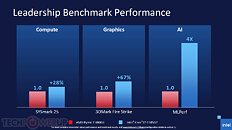
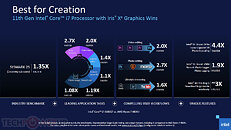
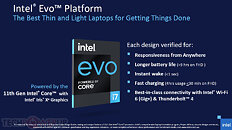
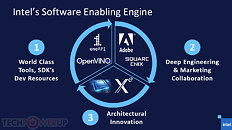




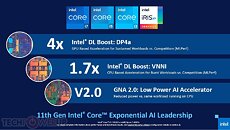


















































69 Comments on Intel 11th Gen Core "Tiger Lake" & Xe Graphics Launch Event: Live Blog
AMD has really been slacking with its APUs. Vega is 3-year-old tech and the only graphics improvement we've ever had in the entire history of Ryzen APUs is the die-shrink allowing more clockspeed and the DDR4 getting faster. AMD have contributed nothing and squandered their advantage.
All the naysayers claim that DDR4 is the bottleneck but if Intel can do 50-100% better whilst still using DDR4 then clearly it's just AMD/RTG slacking.
Does anyone at all think that dropping the APU Vega count (in silicon) from 11 to 8 was a good idea? Vega10 on Raven Ridge and Picasso allowed one defective CU and so there were no availability issues. Meanwhile, Vega 8 in the 4800U is practically unobtainable. It's so rare that even reviewers are unable to get their hands on them and most reviews are of the 4700U because that seems to (realistically) be the top obtainable Renoir U-series SKU.
For the car game - which I think is GRID (2019) based on the screenshot - in addition to the DDR4 vs LPDDR4X memory thing Intel is banking on VRS. Xe has it but AMD will only get support for VRS in RDNA2 which gives Intel some time in the mobile iGPU space to lean on this. Slide deck reveals VRS being pretty heavily used in GRID.
Current implementations of VRS in PC games have had minor impact, with maybe 5% more performance for no visible image quality impact. VRS seems to be getting off the ground though with Xbox Series X slides saying they are looking at 10-30% performance gain (for tiny area cost) from VRS.
Rembrandt in 2H 2022 will probably be a move to DDR5-tuned RDNA1
AMD have lost the IGP advantage, they're too far behind to catch up in the next two years. The only hope is for Rembrandt to undo the damage of Renoir's step backwards (on an already-dated architecture)
www.notebookcheck.net/Vega-8-iGPU-from-upcoming-AMD-Cezanne-laptop-APU-does-not-impress-in-latest-SiSoft-Sandra-benchmarks.483409.0.html
AMD had the resources and expertise to make a 2020 Renoir with 12-16CU of RDNA1 but their excuse was that they were too busy with PS5/XBSX design, Zen3, Big Navi, and Renoir's monolithic design to do anything about the graphics core. They've conceded the win, and IMO slim laptops are the single most important market to concede because that's what 90% of consumers buy.
The next product on the roadmap is for 2H 2022, which is Rembrandt and when last interviewed, RTG said that they were planning to move away from Vega but confirmed it would not (and could not) be brand-new RDNA2/3, but likely a modified version of RDNA1 optimised for DDR5. So, unless AMD change their roadmap now, Vega8 is as good as it gets for another 24 months.
The slides and leaks you see on the web, (eg tekdeeps.com/the-amd-roadmap-confirms-the-apu-architectures-of-cezanne-van-gogh-rembrandt-and-d/) are internal slides for production run, not actual consumer product dates, so Renoir (announced in January, available early April) was roadmapped as mid-2019. Any roadmap that says Q2 2022 will probably result in products available on store shelves in the fall.
I'm sure COVID hasn't helped, but we won't see the real impact that's had on the roadmaps until the next major APU launch (Cezanne)
In AMD's PPT they compare its 45W H series CPU with Intel's 95W desktop 9700k.
Now,
In Intel's PPT they had to label it "Running at 28W PL1" to avoid false advertisement accusations later
Complaining about memory differences or age is pointless, it's comparing a new amd mobile cpu against a new intel mobile cpu. Laptops aren't plug and play lego blocks like desktop or server; you buy into a package. If the cost of the laptops are too different then you have complaints but considering you can't buy either laptop right now...
This was captured closing to the end of a R20 run, using the highest possible power setting available.
It is getting 25W PEAK, not Sustained 25W.
However Intel's 28W PL1 (long-term expected steady state power consumption ) means it is getting Sustained 28W and Peak much more than that.
For example,
The 10900k has PL1 of 125W , PL2 of 250W
So What is the PL2 setting in this Intel PPT TEST ?
The 10th gen 1065g7 is configurable "up to 25W" and has a PL2 of 51W
This one, maybe 57W ?
We all know a 4800u is allowed to have 25W sustained and 42W Peak power in its 25W configuration.
But why Intel's PPT not mentioning "The 4800u is in 25W configuration" ?
They used the name of the Power Profile instead.
Which is laughable.
but as a PR machine INTEL are the Worlds BEST ! They have simply out done them selves this time! IMPRESSIVE ! HAHA
If your product does not stack up, baffle them with bullshit!
We shall see how they really stack up, with hopefully unbiased reviews in the future!
be interesting to see how they go!
While I agree to some extent that AMD should not have regressed from Vega 10/11 to a Vega 8 with Renoir, but it is also proven that the Vega 8 can still be faster than the Vega 10/11 due to the significant clockspeed difference. In addition, I feel the reason why they made the decision to drop from Vega 10 to 8 is likely due to insufficient die space to accommodate an 8 core processor and a bigger GPU. Otherwise I see no reason for them to cut back on the GPU. As to why not RDNA, I suspect it is a stop gap solution to make their GPU more competitive in the short run, but will ultimately be replaced by RDNA2. Which kind of made sense why the rumors mentioned that post Vega, AMD will be using RDNA2 for their APU.
I feel reception to the Tiger Lake announcement seems very poor. In my opinion, Tiger Lake is a significant improvement for Intel, but did not bring anything exciting along with it. Sure the Xe graphics are much faster than their previous UHD graphics, and potentially as fast or faster than AMD's Vega 8, but it is not groundbreaking fast. AMD's APU graphics was significantly faster than any of Intel's UHD graphics back then, to the extend of being 2 to 3x faster in some cases. This was shockingly good back then which stirred up excitement and interest. In this case, Xe may potentially be faster, but the gains is nothing to be excited about in today's context. In addition, any excitement for Tiger Lake probably got tossed out because Intel scheduled their announcement 1 day after Nvidia's Ampere announcement.
Then again on the CPU side of things you have the same 4 core design which is getting long in the tooth in 2020. One can argue that Intel is still supreme when it comes to single core performance, but Renoir packed the surprise of 6 and 8 cores (highly competitive cores) which was unheard of on the ultra low power class of processors. All these likely contributed to making Renoir such a hot topic along with hot demand. I am using an Ice Lake laptop, and to be honest, I can't care much about Tiger Lake. In fact I was thinking of selling it to try out the new 8 core Renoir which sounds more exciting to me.
In saying that, they're making some HUGE claims, and that's against a 25W 4800U, not a power-limited 20W 4700U running regular DDR4 - because that's all that I seem to be able to find on the market anyway. It's not just retail availability of the 4800U that's a problem, there are hardly any reviews of it either!
I'll wait for real-world benchmarks of course, but for Intel to be demonstrating 60% faster than a 4800U is either great news or hell of a lie that will backfire at launch. It's worth noting that very early samples of Xe were shown off at the beginning of the year and even those were matching Vega8.